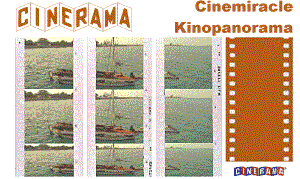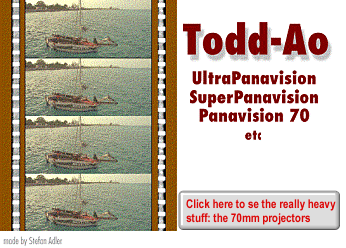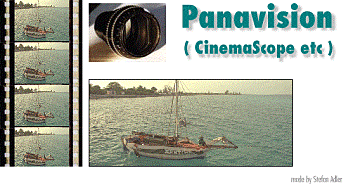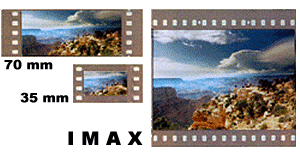
|
"This is Cinerama"! Cinemiracle only used a couple of mirrors as well, so it is pretty much the same - so was the Russian version, Kinopanorama. Three separate films running syncronized at 26 frps with a 35mm 7 track magnetic tape. Clumsy? Sure, but oh so pretty!
You're in the show with Todd-AO
The Todd-AO
system was the first attempt of getting "Cinerama out of one hole". It
is still the nicest looking of all formats if you ask me. It was soon
to be followed by a series of spherical and anamorphic 70mm systems. They
all carried 6-track magnetic stereo, stripped directly to the print.
CinemaScope was the first of the standard film widescreen systems, using 35mm and an optical squeeze of 2x to get in twice the amount of image. Its follower Panavision is still around, though some stupid sods have been utilizing an old even cheaper idea called Super35, which is pretty much the same as supercropped widescreen 2.35:1 ratio standard 35mm spherical, blown up to 35mm anamorphic. Lazy photographers, stupid directors and lack of big screen theatres all blend in the effort of making movies look worse. Who cares - they have digital noise - sorry sound! Super 35 is by far the best action invented for finally and definetly killing widescreen movies.
IMAX - 70mm travelling horizontally with 15 perforations a frame produces beautiful images and a lot of impact to the viewer. Used for education and simulator rides by museums and amusement parks, it has up to now not attracted the guys in the Hollwood establishment. As Home Theatre gets more frequent, better and cheaper, maybe it will? Who'd pay lots of bucks to see a feature in an 80 seat 20 feet screen theatre, when you get about the same impact at home? |
 Visit
my special Cinemiracle & Windjammer section!
Visit
my special Cinemiracle & Windjammer section!Ironically, we should thank the breakthrough of television for big screen cinema. Sure, there had been experiments with wide stuff during the silent era and in the thirties, but it never came into serious use. All this beautiful nonsens started off in 1952 with Cinerama, shortly followed by the quite similar Cinemiracle. The comrades in the USSR replied with Kinopanorama. In order to make the really big screen, you projected three separate 35mm films syncronized into one large screen. The sound was in 7 channel stereo; left, left-centre, center, right, right-centre, right and two surround tracks for sound outside the screen, all carried on a separate 35mm perfo magnetic tape. The systems were complicated and extremely expensive both to shoot and show. It took several projectionist and plenty of room. Thus successfully launched and big audiences, not really many theatres were fitted for it and after beeing competed out by the simpler 70mm bigscreen systems it was abandoned in the early sixties. Here in Sweden it was shown at only four cinemas: Vinterpalatset in Stockholm (Cinemiracle), Draken in Gothenburg (Cinerama), Palladium (small Cinemiracle screen) in Gothenburg and Royal in Malmoe (Cinemiracle). This the first of the modern big screen adventures, was followed by a great number of more or less complicated solutions. If you want to learn more on this in detail, I recommend the splendid website "The American Widescreen Museum" for further studies. There you can read about all possible and impossible solutions, hosted by cameras and projectors since the dawn of man. The first successful try to get Cinerama-impression out of one hole, avoiding the irritating three pannel image was named after its parents Mike TODD and the American Optical company. When shot, it used a 65mm film that was transferred into 70mm prints. The additional 5mm were added to make room for six separate magnetic sound channels, stripped to the prints. Five channels behind the screen and one surround channel with the extra fake channel added on with the Perspecta bi-directional system, made the amount of stereo about the same as on Cinerama. Todd-AO was absolutely delightful! For the first time you could screen really big images with vivid color and superb contrast and focus, without having to be annoyed by Cineramas three-splitted image. The first Todd-AO production was Rogers & Hammersteins OKLAHOMA! (1955), followed by AROUND THE WORLD IN 80 DAYS. Sweden didnīt open with Todd-AO on a larger scale until itīs third production, SOUTH PACIFIC(58) in 1960. 70mm Todd-AO completely whiped out 3-strip Cinerama! The Cinerama theatres were equipped with 70mm projectors and Cinerama launched a new system to fit the 2,2:1 70mm frame into Cineramas 2,75:1. For this they used the UltraPanavision system, a 70mm system with a slight optical squeeze originally developed by MGM as Camera65. The UltraPanavision prints were then rectified for projection on Cinerama's extremely curved screens. The first "one-lens" Cinerama production ever released was the Stanley Kramer production of ITīs A MAD, MAD, MAD, MAD WORLD (1963) and the process of shooting in 3-strip was abandoned. The Cinerama-system was again competable to Todd-AO and lived on until approx 1970. THE SONG OF NORWAY was the last ever filmed and shown in 70mm Cinerama. 70mm Todd-AO and compatible systems for 2,2:1 screens are still around though, even if the era of widesceen pretty much was over in the early seventies, when the moviebusiness backed into the retro-behaviour of low light, fast filmstock with grains the sizes of buses and long focal lengts. The most used 70mm format is Panavisionīs SuperPanavision (a k a Panavision 70 / Panavision Super 70) Iīm sorry to say, that itīs concidered to be to exclusive and expensive. Today there is maybe one feature every five years shot entirely in SuperPanavision, and there hasn't been a movie shot in Todd-AO since 1992. High definition formats like 65mm are almost only used as a special effects format for movies shot in ordinary 35mm Panavision. The most common way to give the audiences a 70mm show, since the middle of the sixties, is to shoot in 35mm and then make blow-ups to 70mm prints. (The first major of these fake 70mm:s was Dr Zhivago in 1966, but others were soon to follow.) By that action you optimize the screening at the cinema, while production companies, often on the edge of bankrupcy, can minimize the expence on the production side. (Of course all the technical stuff in a production is only about 10% of the budget, but who said that movie companies were logical?) 70mm projection is of course always much better than 35mm projection even with this type of action, though it does not in anyway compare with an original production in 70mm. The sixchannel sound is Dolby-encoded today, with the add-on of super low bass and stereophonic surround. Digital soundtracks have alson been introduced for 70mm, with pretty much the same standard as for 35mm prints. Swedish distributors are extremely unliking to the idea of 70mm! So are the international ones. An occational 70mm once and a while dropped down over Swedish cinemas during the nineties, but it's all over today. The number of good places for 70mm have also decreased with the emerge of Cineplexes. I guess itīs all in the plan for profit maximizing?! The last major worldwide 70mm release was Titanic, a less than perfect blow-up (see below). Ah - well; back to the early sixties! Pretty soon production companies and theatre chains relized that they had to get a cheaper big screen format for general release. 20th Century Fox and Bauch&Lomb took and old concept from the silent era. The idea was, to compress twice the amount of image horizontally to the film, by aid of a cylindrical lens system. By projecting the stuff back through the same type of lens, the image had back its normal proportions and you got a wide screen. The system was named CinemaScope and was fitted with four magnetic strips directly on the print for 4 channel stereophonic sound; left - center - right - surround. Sure! It wasnīt as big an impact as Cinerama, but it had reasonable costs, not so much rebuilding needed and was showable with an ordinary crew and withot buying a lot of new gear for the projection room. The first film in CinemaScope was THE ROBE in 1954. Following its success it was simplified for even more theatres to adapt it. The prints were soon fitted with a standard optical mono optical soundtrack etc. Fox even developed a super version of CinemaScope on 55mm film, called CinemaScope55 mostly to enhance the quality on projection by making 35mm reduction prints, but it was run on a few theatres in the US. Only two productions were made in CinemaScope55, "Carousel" and "The King and I". Fox thereafter aquired interests in the Todd-AO process, making Todd-AO their own super format. Today every cinema is equipped for CinemaScope projection. Since the fifties, the system has heavily improved, patent pendings have changed and hysterical amounts of different ways to make the same thing has emerged, all with some kind of catchy name on ...scope or ...rama or ...vision! CinemaScope is no longer in use. It was outrun by Panavision around 1967, a more complete and far better system, though the principle is exactly the same. The four magnetic strips on the 35mm print are also gone. Today the prints carry an improved optical soundtrack, with 4 channel stereophonic sound and Dolby professional noise reduction, developed in the mid seventies, normaly refered to as Dolby Stereo. During recent years this has been added with digital soundtracks. This can either be carried on the print between the sprocket holes as with Dolby Digital or on the film edges like Sony's format, called SDDS - for 4, 6 or 8 channels. The biggest success in digital sound for cinemas in Sweden so far is DTS. This system carries only a time code on the print, between the analog optical track and the image frame, while the sixchannel sound is on separate CD-ROM Discs. Today 35mm films sound fair enough! They donīt look too good though. Not strange concidering the amount of magnifying that small image is going through in a big theatre. To make bad worse, a "new" (it is not, actually) way of destructing definition has emerged called Super35, using spherical non-anamorphic photography and just cropping the print down to 2.35:1 and then making an optical blow-up to anamorphic. This system stinks, which everybody who's seen Titanic, Deep Impact or any Super35 blow-up can tell you. No one have yet come up with an explanation why this format exists. It looks much worse than Panavision 35 and you don't save film stock. Can someone please tell me why! Are the Panavision lenses to heavy for the crew to carry or is some mogul's brother-in-law the inventor of Super35? The latest in high definition big-screen entertainment came in the early 1970:s and is called IMAX. The 70mm film is projected horisontically with a gigantic frame, three times the size of a standard 70mm. It is used mainly for amusement park installations, in planetariums etc or in towns with population enough to carry an event-theatre of its kind. The films shown are mostly short subjects on science or nature - or movies demonstrating the beauty of the system - and beautiful it is! There is a system version called OMNIMAX, projected on a spherical screen. We only have one theatre in Sweden for OMNIMAX and that's in the National Museum of Nature in Stockholm, the Cosmonova. The system is big, loud and produces beautiful images - but like Cinerama in the fifties it has its limitations due to the pretty extreme techiques, though it also comes in both ride- and 3D-versions. One funny thing is, that I've never heard a really good sound presentation in an IMAX theatre... Wonder why? Personally i prefer 70mm Todd-AO in a really big cinema. Thatīs my ultimate viewing pleasure so far - until Imax has leared to tell a story well. The Swedish Widescreen Menu |
Text, images and HTML-layout © 1999-07-01 Stefan Adler - non-commercial use only





